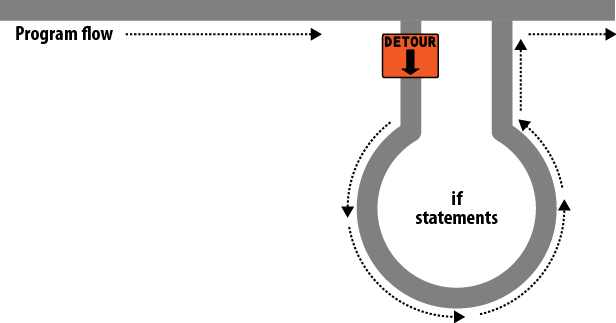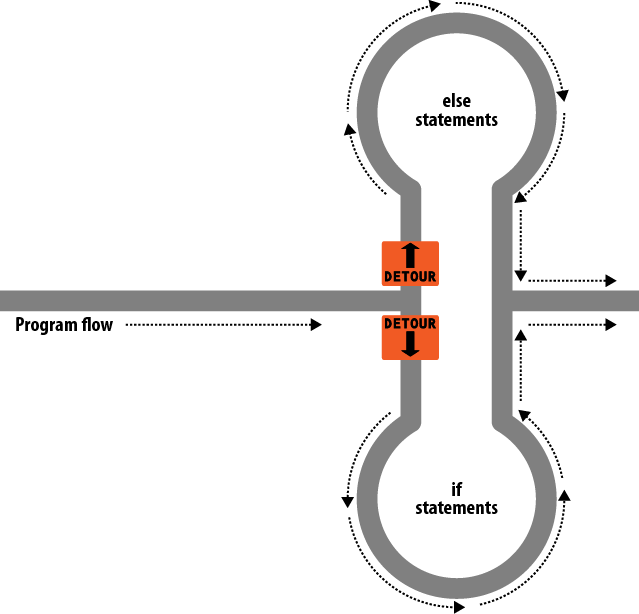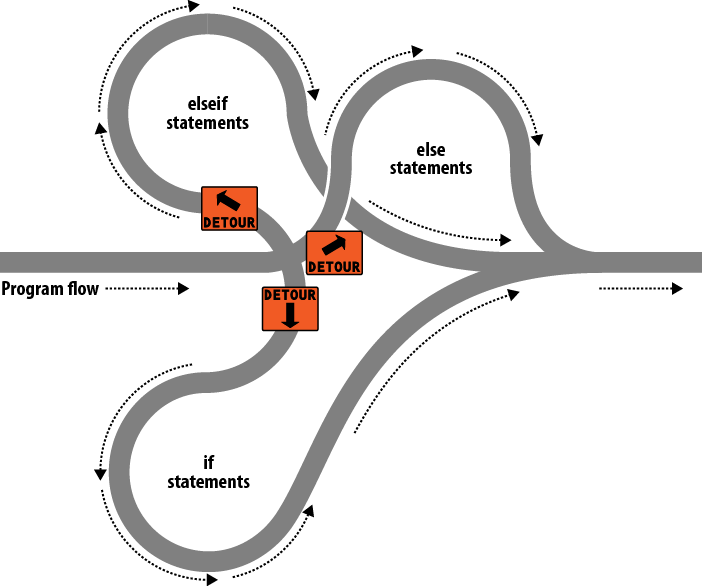Conditionals
Conditionals alter program flow. They enable you to ask questions about certain things and respond to the answers you get in different ways. Conditionals are central to dynamic web pagesâthe goal of using PHP in the first placeâbecause they make it easy to create different output each time a page is viewed.
There are three types of nonlooping conditionals: the if statement, the switch statement, and the ? operator. By nonlooping, I mean that the
actions initiated by the statement take place and program flow then moves
on, whereas looping conditionals (which weâll come to shortly) execute
code over and over until a condition has been met.
The if Statement
One way of thinking about program flow is to imagine it as a single-lane highway that you are driving along. Itâs pretty much a straight line, but now and then you encounter various signs telling you where to go.
In the case of an if statement,
you could imagine coming across a detour sign that you have to follow if
a certain condition is TRUE. If so,
you drive off and follow the detour until you rejoin your original
route; you then continue on your way in your original direction. Or, if
the condition isnât TRUE, you ignore
the detour and carry on driving (see Figure 4-1).
The contents of the if
condition can be any valid PHP expression, including equality,
comparison, tests for zero and NULL,
and even the values returned by functions (either built-in functions or
ones that you write).
The action to take when an if
condition is TRUE are generally
placed inside curly braces, {}. You
can omit the braces if you have only a single statement to execute, but
if you always use curly braces youâll avoid potentially
difficult-to-trace bugs, such as when you add an extra line to a
condition but forget to add the braces in, so it doesnât get evaluated.
(Note that for reasons of layout and clarity, many of the examples in
this book ignore this suggestion and omit the braces for single
statements.)
In Example 4-19, imagine that it is the end of the month and all your bills have been paid, so you are performing some bank account maintenance.
<?php
if ($bank_balance < 100)
{
$money = 1000;
$bank_balance += $money;
}
?>In this example, you are checking your balance to see whether it is less than 100 dollars (or whatever your currency is). If so, you pay yourself 1000 dollars and then add it to the balance. (If only making money were that simple!)
If the bank balance is 100 dollars or greater, the conditional statements are ignored and program flow skips to the next line (not shown).
In this book, opening curly braces generally start on a new line. Some people like to place the first curly brace to the right of the conditional expression instead. Either of these approaches is fine, because PHP allows you to set out your whitespace characters (spaces, newlines, and tabs) any way you choose. However, you will find your code easier to read and debug if you indent each level of conditionals with a tab.
The else Statement
Sometimes when a conditional is not TRUE, you may not want to continue on to the
main program code immediately but might wish to do something else
instead. This is where the else
statement comes in. With it, you can set up a second detour on your
highway, as in Figure 4-2.
What happens with an if...else
statement is that the first conditional statement is executed if the
condition is TRUE, but if itâs
FALSE, the second one is executed.
One of the two choices must be executed. Under no
circumstances can both (or neither) be executed. Example 4-20 shows the use of
the if...else structure.
<?php
if ($bank_balance < 100)
{
$money = 1000;
$bank_balance += $money;
}
else
{
$savings += 50;
$bank_balance -= 50;
}
?>In this example, having ascertained that you have over $100 in the
bank, the else statement is executed,
by which you place some of this money into your savings account.
As with if statements, if your
else has only one conditional
statement, you can opt to leave out the curly braces. (Curly braces are
always recommended, though: they make the code easier to understand, and
they let you easily add more statements to the branch later.)
The elseif Statement
There are also times when you want a number of different
possibilities to occur, based upon a sequence of conditions. You can
achieve this using the elseif
statement. As you might imagine, it is like an else statement, except that you place a
further conditional expression prior to the conditional code. In Example 4-21, you can see a
complete if...elseif...else
construct.
<?php
if ($bank_balance < 100)
{
$money = 1000;
$bank_balance += $money;
}
elseif ($bank_balance > 200)
{
$savings += 100;
$bank_balance -= 100;
}
else
{
$savings += 50;
$bank_balance -= 50;
}
?>In this example, an elseif
statement has been inserted between the if and else
statements. It checks whether your bank balance exceeds $200 and, if so,
decides that you can afford to save $100 of it this month.
Although Iâm starting to stretch the metaphor a bit too far, you can imagine this as a multiway set of detours (see Figure 4-3).
Note
An else statement closes one
of the following: an if...else
statement or an if...elseif...else
statement. You can leave out a final else if it is not required, but you cannot
have one before an elseif; neither
can you have an elseif before an
if statement.
You may have as many elseif
statements as you like, but as the number of elseif statements increases it becomes
advisable to consider a switch
statement instead, if it fits your needs. Weâll look at that
next.
The switch Statement
The switch statement is useful
in cases in which one variable or the result of an expression can have
multiple values, which should each trigger a different
function.
For example, consider a PHP-driven menu system that passes a
single string to the main menu code according to what the user requests.
Letâs say the options are Home, About, News, Login, and Links, and we
set the variable $page to one of
these, according to the userâs input.
The code for this written using if...elseif...else might look like Example 4-22.
<?php if ($page == "Home") echo "You selected Home"; elseif ($page == "About") echo "You selected About"; elseif ($page == "News") echo "You selected News"; elseif ($page == "Login") echo "You selected Login"; elseif ($page == "Links") echo "You selected Links"; ?>
Using a switch statement, the
code might look like Example 4-23.
<?php
switch ($page)
{
case "Home":
echo "You selected Home";
break;
case "About":
echo "You selected About";
break;
case "News":
echo "You selected News";
break;
case "Login":
echo "You selected Login";
break;
case "Links":
echo "You selected Links";
break;
}
?>As you can see, $page is
mentioned only once at the start of the switch statement. Thereafter, the case command checks for matches. When one
occurs, the matching conditional statement is executed. Of course, in a
real program you would have code here to display or jump to a page,
rather than simply telling the user what was selected.
Note
One thing to note about switch statements is that you do not use
curly braces inside case commands.
Instead, they commence with a colon and end with the break statement. The entire list of cases in
the switch statement is enclosed in
a set of curly braces, though.
Breaking out
If you wish to break out of the switch statement because a condition has
been fulfilled, use the break
command. This command tells PHP to break out of the switch and jump to the following
statement.
If you were to leave out the break commands in Example 4-23 and the case of âHomeâ evaluated to be TRUE, all five cases would then be executed.
Or if $page had the value âNews,â
all the case commands from then on
would execute. This is deliberate and allows for some advanced
programming, but generally you should always remember to issue a
break command every time a set of
case conditionals has finished
executing. In fact, leaving out the break statement is a common error.
Default action
A typical requirement in switch statements is to fall back on a
default action if none of the case
conditions are met. For example, in the case of the menu code in
Example 4-23, you could add the code in
Example 4-24 immediately
before the final curly brace.
default: echo "Unrecognized selection";
break;Although a break command is
not required here because the default is the final substatement, and
program flow will automatically continue to the closing curly brace,
should you decide to place the default statement higher up it would
definitely need a break command to
prevent program flow from dropping into the following statements.
Generally, the safest practice is to always include the break command.
Alternative syntax
If you prefer, you may replace the first curly brace in a
switch statement with a single
colon and the final curly brace with an endswitch command, as in Example 4-25. However, this approach
is not commonly used and is mentioned here only in case you encounter
it in third-party code.
The ? Operator
One way of avoiding the verbosity of if and else
statements is to use the more compact ternary operator, ?, which is unusual in that it takes three
operands rather than the more usual two.
We briefly came across this in Chapter 3 in the discussion about the difference
between the print and echo statements, as an example of an operator
type that works well with print but
not echo.
The ? operator is passed an
expression that it must evaluate, along with two statements to execute:
one for when the expression evaluates to TRUE, the other for when it is FALSE. Example 4-26 shows code we might use for
writing a warning about the fuel level of a car to its digital
dashboard.
<?php echo $fuel <= 1 ? "Fill tank now" : "There's enough fuel"; ?>
In this statement, if there is one gallon or less of fuel (in
other words, if $fuel is set to
1 or less), the string âFill tank
nowâ is returned to the preceding echo statement. Otherwise, the string âThereâs
enough fuelâ is returned. You can also assign the value returned in a
? statement to a variable (see Example 4-27).
<?php $enough = $fuel <= 1 ? FALSE : TRUE; ?>
Here, $enough will be assigned
the value TRUE only when there is
more than a gallon of fuel; otherwise, it is assigned the value FALSE.
If you find the ? operator
confusing, you are free to stick to if statements, but you should be familiar with
it because youâll see it in other peopleâs code. It can be hard to read,
because it often mixes multiple occurrences of the same variable. For
instance, code such as the following is quite popular:
$saved = $saved >= $new ? $saved : $new;
If you take it apart carefully, you can figure out what this code does:
$saved = // Set the value of $saved
$saved >= $new // Check $saved against $new
? // Yes, comparison is true ...
$saved // ... so assign the current value of $saved
: // No, comparison is false ...
$new; // ... so assign the value of $newItâs a concise way to keep track of the largest value that youâve
seen as a program progresses. You save the largest value in $saved and compare it to $new each time you get a new value.
Programmers familiar with the ?
operator find it more convenient than if statements for such short comparisons. When
not used for writing compact code, it is typically used to make some
decision inline, such as when testing whether a variable is set before
passing it to a function.
Get Learning PHP, MySQL, JavaScript, and CSS, 2nd Edition now with the O’Reilly learning platform.
O’Reilly members experience books, live events, courses curated by job role, and more from O’Reilly and nearly 200 top publishers.




